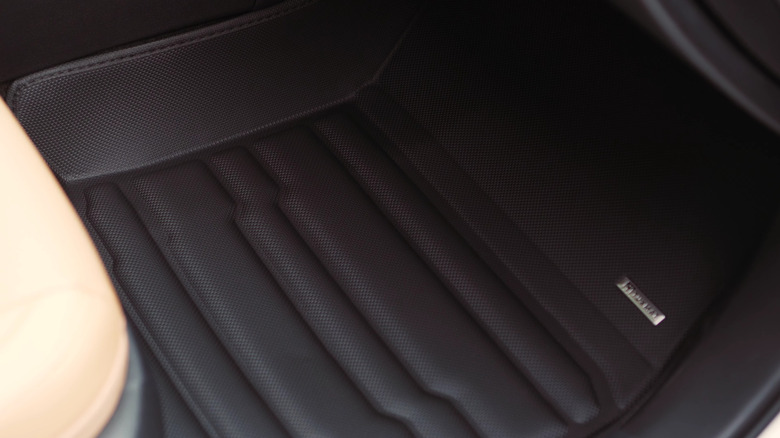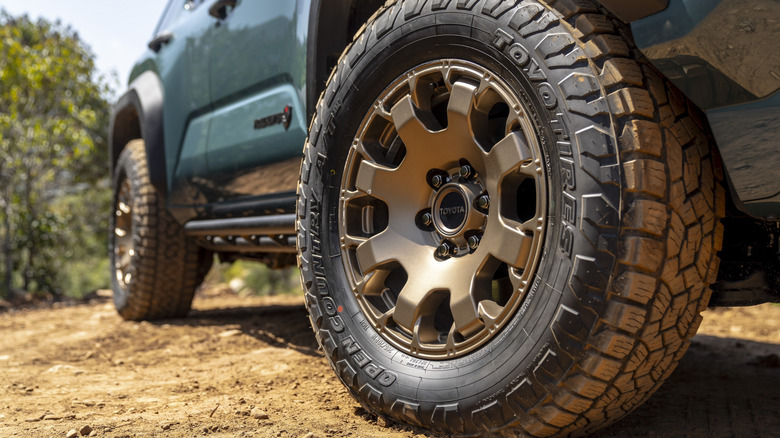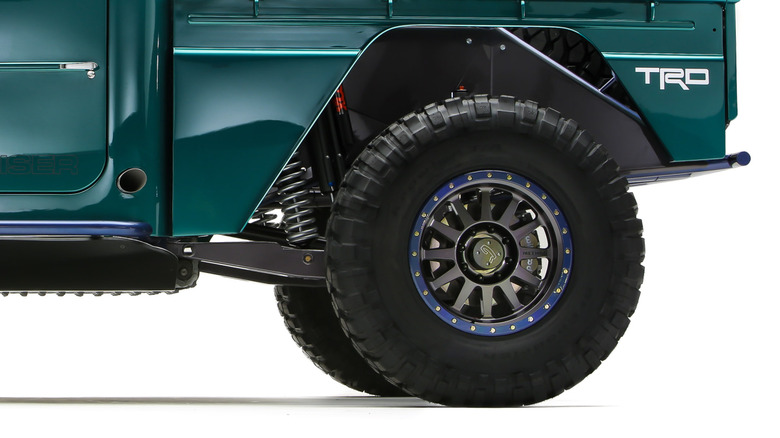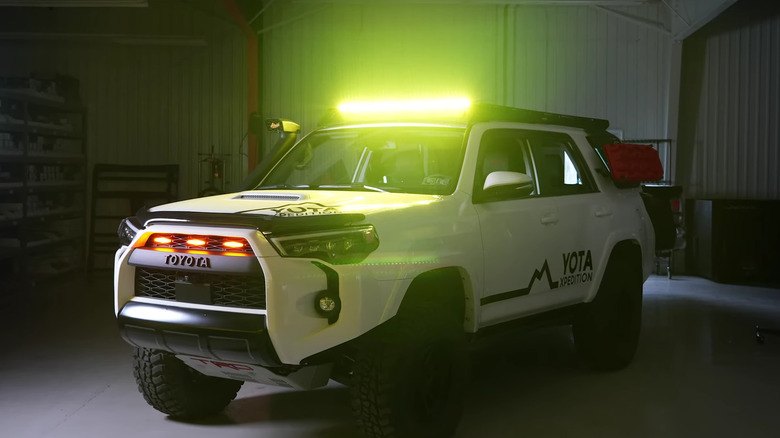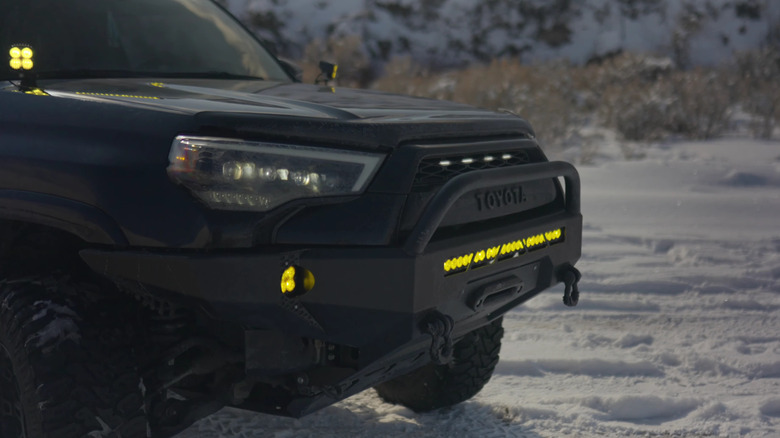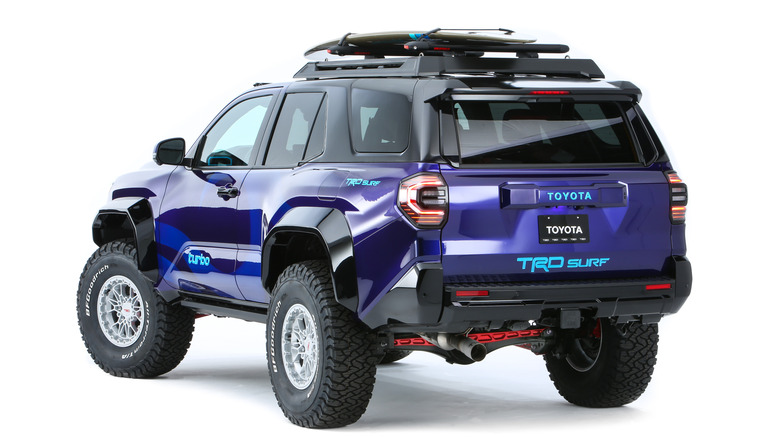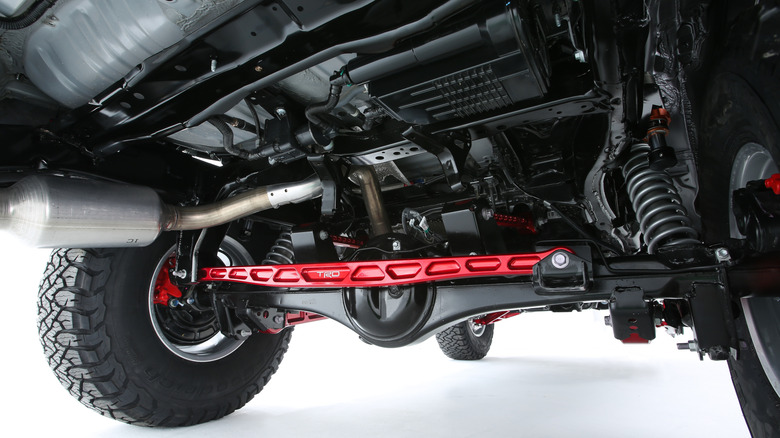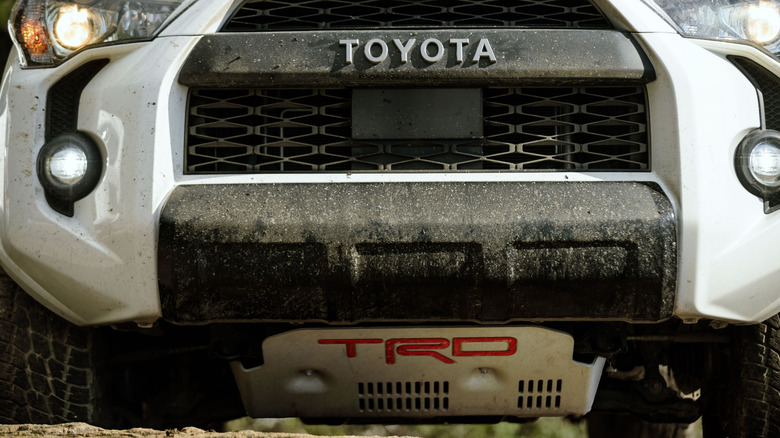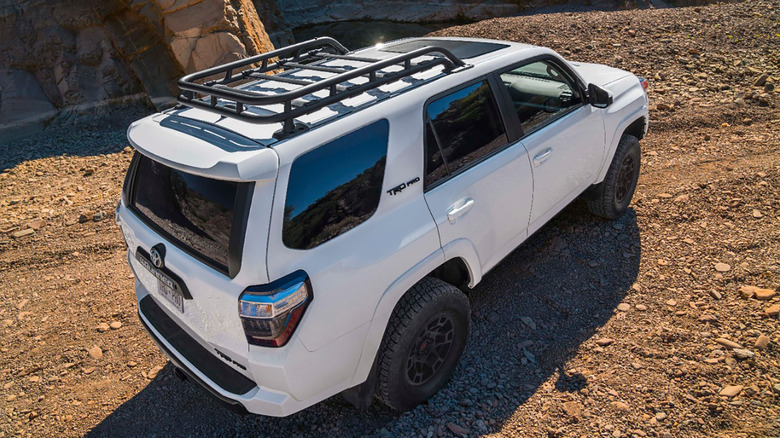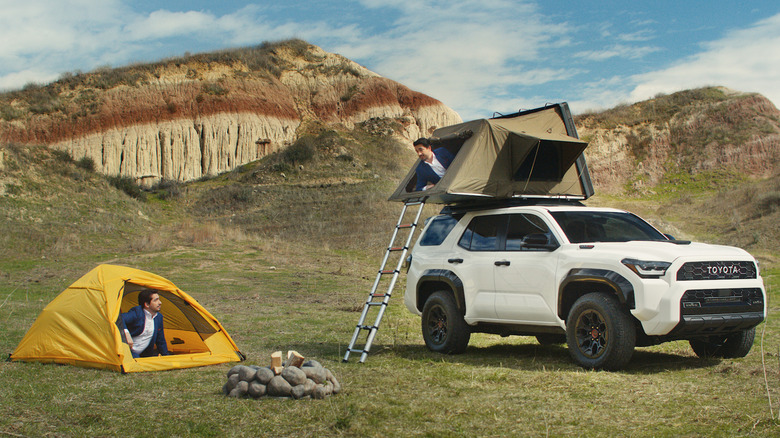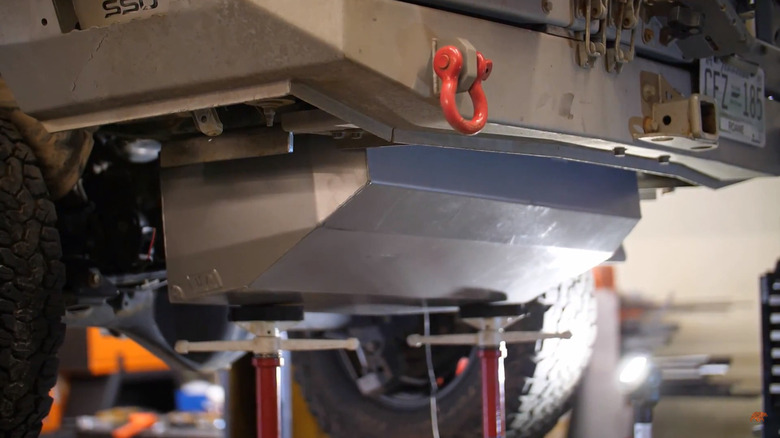13 Accessories & Upgrades That Will Level Up Your 4Runner
We may receive a commission on purchases made from links.
The 2025 Toyota 4Runner has been improved significantly, packing a brand-new 2.4-liter turbo four, and an available electrified version of the same engine. Toyota has also doubled down on the off-road trims — drivers can now choose between the TRD Pro Baja-style machine and Trailhunter overlanding rig.
Still, the 4Runner has always been a rugged, body-on-frame SUV, designed to tackle highways and challenging terrains. Crucially, the 4Runner is a popular platform for serious off-road builds, thanks to its sturdy frame and reliable mechanics. In other words, you can level up your 4Runner with many accessories and upgrades, turning it into an even more capable SUV.
In this article, we'll have a closer look at all the upgrades you can make to your 4Runner. Some will make your daily drive more bearable. Others will transform the popular SUV into a Jeep-beater. We strongly recommend improving only the parts you really need, as spending money on unnecessary accessories won't improve your ride.
All-Weather Floor Liners
Most owners use their 4Runners on paved roads, where textile floor mats are probably the best solution. Even for the winter, rubber mats should be protective enough. However, if you are off-roading frequently, we strongly recommend using all-weather floor liners, which protect your 4Runner's carpeting much more successfully from mud, snow, and moisture.
For starters, floor liners are often made of durable materials that can take a lot of abuse. Furthermore, floor liners are raised on the sides, which allows them to hold more water and debris. Manufacturers often incorporate channels and reservoirs to trap moisture. Crucially, liners are designed to cover a much larger area, protecting your 4Runner's carpet in addition to the sides, door sills, and transmission tunnel in the back. Finally, floor liners are easy to clean and dry in minutes. There are many all-weather floor liner brands that have 4Runner-specific models. Still, the ones we trust most are SmartLiner, WeatherTech, and TuxMat.
For instance, SmartLiner model costs $93.46 on Amazon is odor-free and fits the previous-gen 4Runner (2013 to 2022) like a glove. WeatherTech's floor liners are usually more expensive, like the front-row ones for the 1996-2002 4Runner, which cost $146.95 on Amazon. However, they are made from the brand's patented, more rigid High-Density Tri-Extruded (HDTE) material. They also contain more water channels. Finally, TuxMat's front/rear floor liners for the previous gen 4Runner cost $229.80 on Amazon but have significantly higher lips for even better protection. Owners also praise the thick, high-quality material.
All-Terrain or Off-Road Tires
Most Toyota 4Runner trims come with regular all-season tires, which are only really useful on paved roads and mild terrain like gravel. Thus, Toyota equips the off-road-focused 4Runner trims, like the TRD Pro and Trailhunter, with all-terrain tires. These have a more aggressive tread pattern with deeper grooves and larger blocks, helping them cling to various terrains and provide traction. Put simply, a set of all-terrain tires will immediately improve the off-road credentials of your 4Runner.
However, there is a huge difference between various all-terrain tires. We can generally put them in two categories: on-road and off-road. The former offer higher off-road traction than a regular all-season tire but are still mostly designed for paved roads. Meanwhile, off-road all-terrain tires have a more aggressive tread pattern for higher road traction at the expense of on-road grip.
Currently, the best off-road all-terrain tire for the 4Runner is the Mickey Thompson Baja Boss A/T. Off-roaders love the off-road traction this tire offers, and it's quiet on the road. It also costs just $222.89 on Amazon (265/70R17). For a milder all-terrain option, we'd recommend the Vredestein Pinza A/T, which offers good dry, wet, and snow grip.
But what if you want to improve on the already good Toyo Open Country A/T IIIs on the latest 4Runner TRD Pro? You can do that with special off-road tires, like the General Grabber X3. With its aggressive tread pattern, this tire will give you unmatched off-road traction, regardless of the terrain.
Beadlock Wheels
A good set of all-terrains will improve off-road traction significantly, but you can get things up a notch if you air down those tires. At lower psi, the tire will more easily conform to the surface, thus increasing the contact patch. Between 20 and 25 psi, you'll have more traction in mud or over large stones, while lower pressures introduce floating on sand, i.e., reduce sinking.
The problem is, though, this can lead to tire damage or de-beading, i.e, the tire separating from the rim. You can solve this by using beadlock wheels. These lock the bead into place and allow you to drive at very low pressures without worrying about de-beading. Beadlock wheels have an additional metal ring that keeps the tire sealed in place, which is tightened using a series of bolts positioned near the wheel's rim. They are also made tougher and can sustain more abuse than regular tires. It's important to note that beadlock wheels are also significantly heavier and quite expensive.
Toyota doesn't offer beadlock wheels as an OE solution on the 4Runner, even in the TRD Pro model. Fortunately, the market is full of models that fit the 4Runner. Just make sure you get the right size — Hardrock Offroad has a useful guide to help you. Still, most beadlock wheels are not DOT-approved, i.e. not legal for highway use. Thus, if you want to retain your 4Runner's go-anywhere capability, we'd recommend hybrid beadlocks which can also be used as regular street wheels.
Auxiliary Off-Road Lighting
4Runner's headlights do an excellent job of illuminating the road ahead. However, they are designed to give you the best visibility at 300 feet (low beams) and 500 feet (high beams). For off-roading, you'd want to see what's right in front of your 4Runner to avoid obstacles.
Thus, if you plan on overlanding with your 4Runner, we highly recommend installing auxiliary off-road lights. Toyota already installs such lights on the off-road-focused 4Runners, but you can get even better solutions aftermarket. Today, most off-road lights are LEDs, though they come in different color temperatures. Choose what you like, but daylight (4500K) should be your starting point.
As far as models, the most popular solution is light bars. You can put these on the grille to illuminate the terrain in front of your SUV or the roof to light up the surrounding area. These Spot/Flood lights from Nilight will do both and cost just $53.09 on Amazon. You might also want to add rock lights, illuminating obstacles under and around your 4Runner. They are also relatively inexpensive; eight Yoneda rock lights cost $37.99 on Amazon, enough to illuminate everything under your 4Runner.
Bumpers that Improve Approach/Departure Angles
Approach and departure angles determine how steep a slope a vehicle can ascend/descend without touching the ground. The 2025 4Runner has an 18-degree approach and 22-degree departure angles, while the TRD Pro/Trailhunter models push those to 33 degrees and 24 degrees, respectively.
These are good figures but seasoned off-roaders mod their SUVs/trucks to go even further. To do that, you'll need special off-road bumpers that improve approach and departure angles. These aftermarket bumpers usually sit higher from the ground and have special designs that improve those angles. However, they are also made from sturdy metal and offer much higher impact resistance. Crucially, they are designed to fit a winch, which is another important off-road addition.
The 4Runner is well-supported by aftermarket off-road bumper manufacturers. There is everything from minimalistic kits to serious bumpers with bull bars for ultimate protection. Some models also come with built-in off-road LED lights.
Lift Kit
Off-road bumpers will increase approach/departure angles, but do nothing about the breakover angle. Basically, the higher the road clearance, the better the breakover angle. The 2025 4Runner TRD Pro has a solid 10.1-inch road clearance, but for real off-roading shenanigans, you'll want to go even further with a lift kit.
Lift kits are pretty self-explanatory — they lift the vehicle to increase road clearance. In addition, they allow you to run larger wheels and tires on your 4Runner. The end result — your 4Runner can go over even taller obstacles without touching the ground. The best part is that basic lift kits with spacers are relatively inexpensive. This Rough Country 2-inch lift kit is only $139.95 on Amazon and fits 2010-2024 4Runners.
There are still some downsides to consider. Lift kits won't hurt your 4Runner, but they will worsen its on-road driving dynamics. Expect more body roll in the corners and generally a less stable drive. In addition, you might experience worse ride quality. Ingress/egress will also be more challenging. Finally, while you can tow with a lifted 4Runner, you might need to make some additional adjustments to ensure safety.
Off-Road-Specific Shock Absorbers/Springs & Coilovers
Lift kits will give you more leeway on challenging terrains, but a set of quality aftermarket shock absorbers, springs, or coilovers will also improve off-road stability, wheel travel/articulation, and ride quality. These are important traits if you are serious about off-roading. Toyota knows that and equips the 2025 4Runner Trailhunter with Old Man Emu dampers. Meanwhile, the TRD Pro gets adjustable Fox Racing QS3 internal-bypass shocks.
Why the difference? Well, Trailhunter's shocks are designed for the trail, where you would overcome tall obstacles while driving more slowly (think overlanding, or even rock crawling). Still, you can get even better aftermarket shocks, which allow for compression/rebound adjustment, and even height adjustment. This is important on 4Runner overlanding builds, as you can counteract the added weight and ensure your SUV doesn't bottom out on the trail. As far as brands go, Old Man Emu is the gold standard in trail shocks, though Fox has some excellent models on its own.
On the other hand, valved shocks with internal bypass, like the ones in the TRD Pro, are more geared toward Baja-style performance driving in the desert. These will offer a softer ride at speed while retaining stability. Moreover, performance shocks are sturdier and designed to take more abuse. Fox, King Shocks, and Icon Vehicle Dynamics all make excellent performance shocks and coilovers (shocks+springs). It's important to note that all these aftermarket suspension systems will lift your 4Runner, so there is no need for a lift kit.
Winch
Even with the 4Runner TRD Pro's advanced 4WD system and beefiest off-road tires, chances are you'll get stuck. This won't only ruin your day, but being left stranded is also dangerous. Fortunately, a winch can solve those issues and turn your 4Runner into an unstoppable machine.
A winch is a mechanical device that can pull your SUV using a drum that winds a cable, rope, or chain. Depending on the model, it runs either on electricity or hydraulics. In both cases, it draws power from your 4Runner; electric winches connect to the SUV's electric system, while hydraulic winches draw power from the power steering pump. Since the 4Runner isn't a very heavy SUV, you'd be looking mostly at electric winches. Choose models with at least a 9,500-pound pull rating. For safety, we'd recommend the affordable OPENROAD 12,000-pound winch, which costs $369.99 on Amazon.
The way winches work is very straightforward. They are mounted on the front of the vehicle, though you can also mount them in the back. Then, find a strong static object, like a bigger tree, and secure the provided hook or attachment point around it. Pull out the cable from the winch and attach it to the anchor point. Finally, start the winch and operate it slowly and carefully while monitoring the rope for possible overloading. Always wear gloves, make sure people are at least 50 feet away, and use a winch dampener to reduce the risk of a broken cable whipping around and hurting somebody.
Underbody/Frame Protection
Installing good underbody protection is really a no-brainer if you plan on taking your 4Runner off-road. Even on lifted 4Runners, you will inevitably bottom out in some circumstances, which can do a lot of underside damage, piercing the sump, and leaving you with no engine oil in the middle of nowhere (or damaging the transmission and differentials). Even worse, it could damage the frame, leading to expensive repairs.
Installing protection for each of these parts might not always be necessary. If you only navigate through forest trails, skid plate should be enough. Toyota already equips the TRD Pro and Trailhunter with a skid plate, but you can get sturdier aftermarket solutions. Just make sure you don't plastic underbody shields, because they offer almost no protection. High-grade steel is the best option, though aluminum could also work.
For more serious off-roaders, protecting the transmission and differential is also important, particularly if you go rock crawling. You'll find multiple solutions, like heavy-duty housings and covers. Meanwhile, to protect the frame, you should be looking at rock sliders. These are installed directly on the frame, protecting it from large rocks. Good rock sliders are made from high-strength steel and can withstand the weight of the vehicle without getting too much damage.
Snorkel
Snorkels are a great addition to any SUV or truck that spends most of its time in the wilderness. They are designed to feed air into the engine from the roof of the vehicle, which has several benefits. Because the air intake is now higher, less sand and dust will enter the system than a regular air intake. This can clog the air filter, necessitating frequent cleanings and replacements.
Most notably, though, snorkels are used to improve the wading depth of SUVs. With a normal air intake, going too deep will flood the engine with water. This will cause stalling — not something you want when driving through rivers. With a snorkel, you can go much deeper without worrying about flooding your engine.
The 2025 4Runner Trailhunter comes with a built-in snorkel. However, it's quite rudimentary, as it isn't sealed. In other words, it will keep dust from entering the engine but not water. Luckily, 4Runner snorkels are fairly inexpensive; Ledin's waterproof snorkel is compatible with the fifth-gen 4Runner and costs $129.98 on Amazon.
Roof Rack & Exterior Storage Panels
The latest two-row 4Runner allows you to pack quite a lot of stuff for an overland expedition, thanks to its sizeable 48.4-cubic-inch trunk. Still, for many people, that won't be enough. Moreover, the three-row 4Runner only has a limited 12.1-cubic-inch cargo capacity behind the third row. Thus, you'll need a roof rack if you are serious about camping and overlanding. You can put anything on this rack, from bicycles and kayaks to roof boxes that act like additional trunks.
Roof racks come in different designs. The simplest solution is legs/crossbars roof racks. These should be practical enough for most people, as they allow for carrying longer items. They are affordable, too, and can be installed in minutes. Platform roof racks offer much greater versatility, and fit the 4Runner's purpose better. They come in half-platform, ¾-platform, or full-platform sizes, and can be used to attach just about anything — including smaller items. They also have a larger footprint, and much higher carrying capacities.
An even better version of platform roof racks would be basket roof racks. These are raised on the sides and have a stretchy cargo net to keep attached items from falling off. The side rails also give you more anchor points. Some models also come with waterproof cargo bags. This affordable ($169.99 on Amazon) PINGDIR roof basket made from high-strength steel tubing is a good example.
Rooftop Tent
Rooftop tents are a great addition to overlanding 4Runner builds. Yes, a regular tent will also work, but there are reasons rooftop tents are becoming increasingly popular among the outdoor folks. To begin with, they are much easier to set up and take down — no special techniques required. They are also flat and come with built-in mattresses for more comfort, which don't need to be inflated; let's also not forget that you'll avoid rocks and branches ruining your sleep. Because they sit higher from the ground, rooftop tents keep you safe from standing water and animals and don't get as dirty. The view from up there is also excellent, though going downstairs for a midnight relieve can be annoying.
Still, there are some things to consider before buying a roof tent for your 4Runner. You must ensure it fits — the rooftop tent shouldn't be longer/wider than the roof. Moreover, it might not be compatible with your roof rack and might overcome its carrying capacity. As for models, you'll choose between hard-shell and soft-shell rooftop tents. The former are easier to set up and offer better insulation but are smaller inside and heavier. Meanwhile, soft-shell rooftop tents are lighter and more compact when not in use.
Auxiliary Fuel Tank
By now, you'd think you've equipped your 4Runner with everything necessary to reach the most remote places and sleep there. However, there is one last piece of the puzzle — an auxiliary fuel tank. The 2025 4Runner, for instance, has a 19-gallon fuel tank and a 22-mpg combined rating, enough for a 420-mile range. The previous-gen 4Runner had a larger 23-gallon fuel tank but a much worse fuel economy of 17 mpg, meaning a shorter 390-mile range.
Still, you'll be spending much more fuel during off-roading. That added weight from off-road tires, beadlock wheels, and cargo worsens fuel economy, and you'll be driving at low speeds and high rpm most of the time. If you want to reach remote places and then return, we strongly recommend installing an auxiliary fuel tank.
Aftermarket solutions that will fit your 4Runner are available, like this 24-gallon tank from Long Range America that fits the fifth-gen model. It will more than double the range of the 4Runner. Moreover, it supports split fill, meaning you'll fill your 4Runner through the same fuel door.

